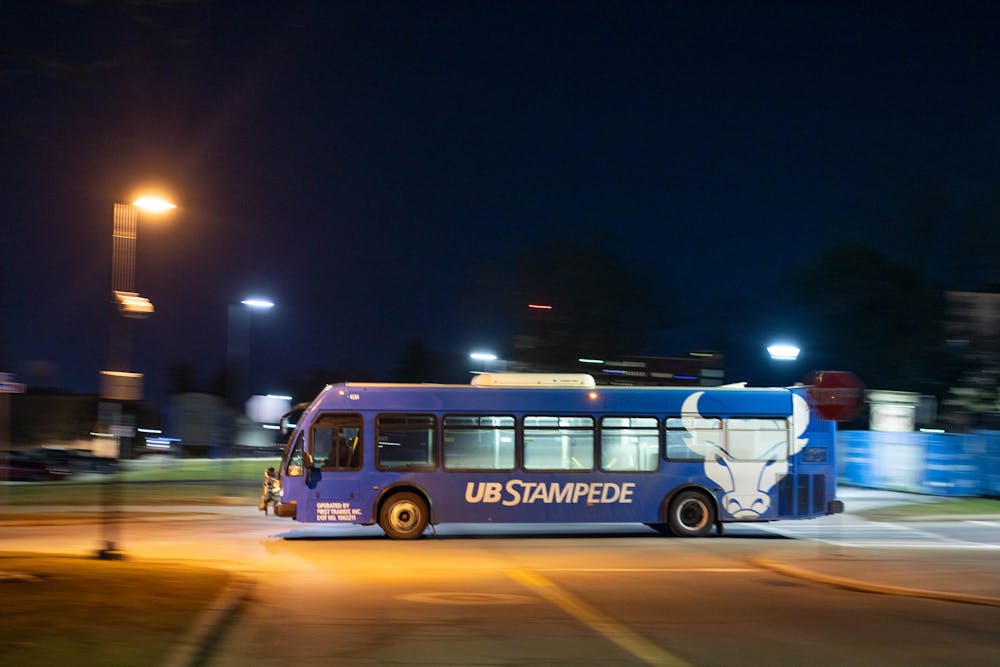UB will miss its 2025 goal for complete electrification of the Stampede and campus shuttle bus fleets, Chief Sustainability Officer Ryan McPherson confirmed in an email last Friday.
The original goal was set in 2020 as part of UB’s Climate Action Plan, which calls to “transition the University’s bussing contract and internal bussing services to 100% electrification by 2025.” Currently, UB has no active electric buses or shuttles.
Stampede buses are owned by a contractor, and UB does not count them as part of its fleet. When UB’s next Stampede contract takes effect, it will call for 40% of the Stampede bus fleet to be electric within the next two years, McPherson said. When asked, McPherson said full electrification of the bus fleet is still a goal, but he did not provide a timeline.
Between high costs and cold climates, few campuses nationwide are going fully electric, Parking & Transportation Services Director Chris Austin said in an email to The Spectrum.
“It’s a risky proposition when transit is responsible for moving 16,000+ passengers a day,” Austin wrote. “The fleet mix we’ll be implementing reduces risk and ensures we have a reliable transportation system.”
Austin said electric buses cost as much as $1 million, more than double the typical purchase price of a current Stampede bus.
“It is our hope that over the coming three to five years, the batteries powering the buses continue to improve, adoption of use increases and the up-front cost in turn comes down,” he wrote.
McPherson said that UB compares favorably to its peers in sustainability, but that its three campuses create a challenge.
“On the broader emissions front, we are in one of the better spaces and probably in the top 10%,” he wrote.
While the NFTA Metro Rail connects UB’s two city campuses, the Stampede is the only frequent service between the North and South campuses. Completion of the rail line to Amherst has been saddled with more than a half century of delays, opposition and funding problems.
Meanwhile, other agencies have begun adding EVs to their bus fleets. Ten electric buses now run within NFTA-Metro’s 299-bus fleet. NFTA Public Information Officer Kelly Khatib says that besides a voluntary recall last year, the buses have been a success.
“We haven’t had any issues with our electric buses. They have been running trouble-free,” Khatib said. “We’re actually very happy to have them, with clean energy.”
Other universities have also expanded their electric bus fleets. The University of Georgia (UGA) used federal and state grants to purchase 20 Proterra electric buses in 2019, and now operates 33 electric buses. UGA says its electric buses cost $10 per day in energy (compared to $100 for ICE buses) and cost nearly 65% less to maintain.
UB estimates the Stampede transported roughly 2.8 million passengers last year, and its 15 campus shuttles carried 260,782. That capacity comes at an environmental cost: the Stampede’s 28 buses use more than 150,000 gallons of fuel annually, Austin said in a 2021 video.
But drivers’ emissions dwarf the Stampede’s: UB commuters emitted 25,781.41 metric tons of carbon dioxide equivalent (MTCDE) in 2019. That figure is equivalent to more than 2.9 million gallons of gasoline, 19 times more fuel than the Stampede uses.
Besides shuttle buses, UB operates 321 cars, trucks and vans, including 26 electric vehicles (EVs) and two hybrids. Twelve of those EVs — all of them Ford E-Transit work vans — were purchased in 2023, and seven were purchased in 2022. A self-driving electric bus is set to arrive on the Medical Campus this summer.
UB reported nearly 20% lower fleet emissions in 2023 than in 2019, a reduction of 411.36 MTCDE, from 2,057.81 to 1,646.45 MTCDE. 2023’s numbers were similar to emissions during 2020 and 2021 when the COVID-19 pandemic emptied the campus and reduced UB services.
UB’s climate plan calls for the university to switch its purchasing to EVs “where technically and economically feasible” by 2025.
McPherson said that a gradual transition prevents the waste of working vehicles.
“We would not be stewarding taxpayer dollars responsibly, nor would it be a good sustainable practice, to discard all ICE vehicles before they reached end of life,” he wrote.
Sol Hauser is the senior news editor and can be reached at sol.hauser@ubspectrum.com





